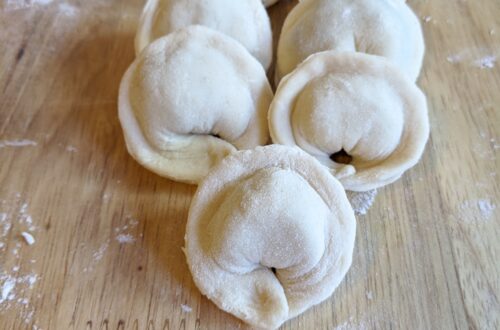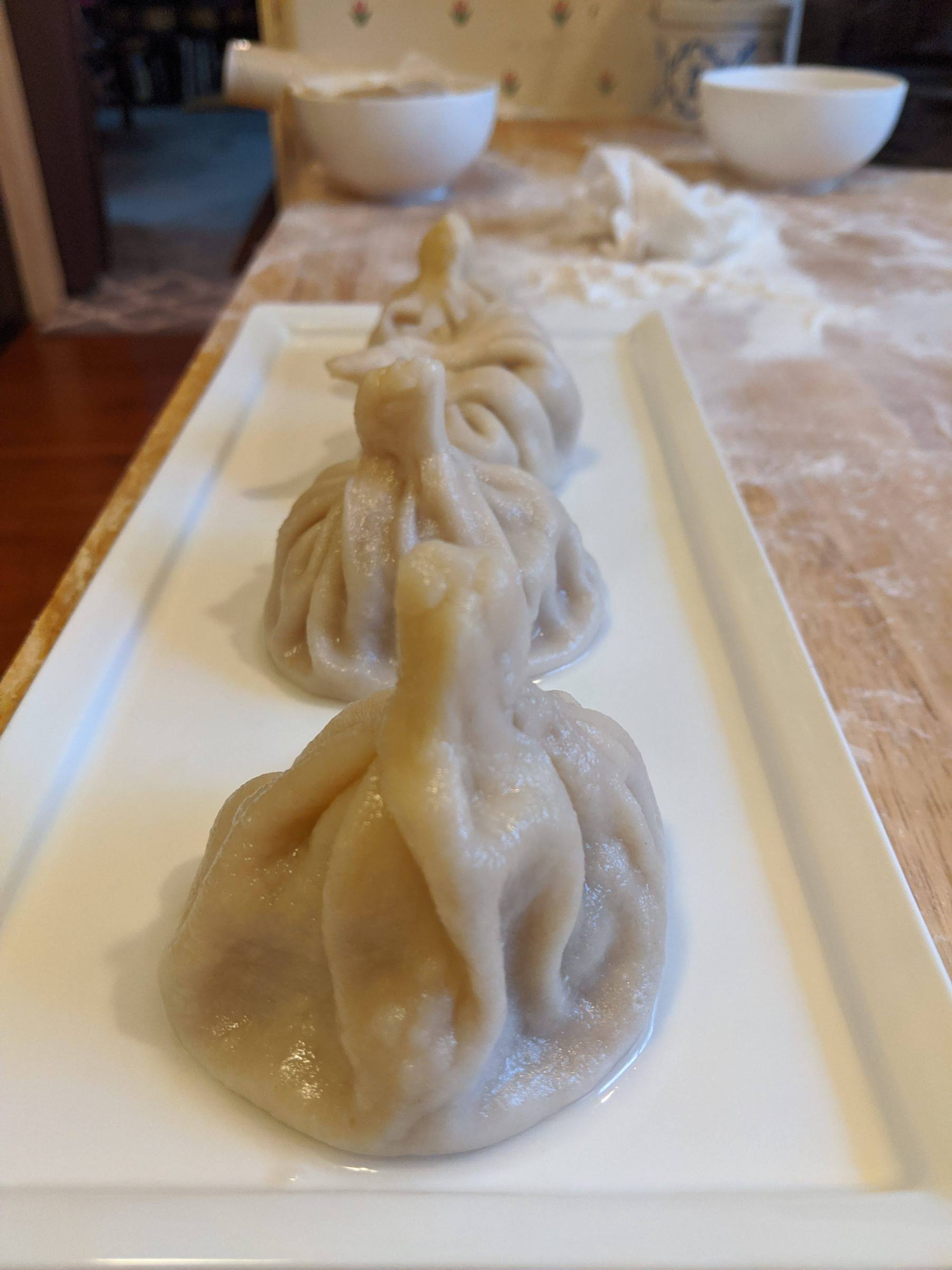Last year, I was lucky enough to spend the month of November as a temporary resident of Luxembourg. I had a marvelous time, enjoyed tons of interesting food and experiences, but the thing I enjoyed most was discovering raclette. Apparently, this is a winter-time treat enjoyed throughout this region of Europe and, because I love cheese more than a normal amount, this delicious meal of pure, melted cheese served with sliced meats, boiled potatoes, and steamed veggies, was amazing.

Epic Raclette, for reference
But today, we are not here to talk about raclette. It seems that, in my haste to eat raclette everywhere I found it last year, I might have missed out on another deliciously cheesy dish: tartiflette. Clearly nothing can have more cheese in it than raclette, as even fondue is sullied with white wine and spices. But tartiflette is a monster all its own.
I discovered tartiflette on Youtube, of all places, not at the storied Christmas markets of Europe. I was watching random Chef John/Food Wishes videos and happened across the tartiflette one completely by chance. The instant I finished that video, I knew that was my next kitchen experiment. I went out, purchased all of the necessary ingredients, and made a little mini one for myself one weekend while my husband was out at a concert. He’s lactose intolerant, so it seems rude to have such an indulgent cheese meal that he can’t enjoy. Anyway, first attempt at tartiflette was out-of-this world delicious, and every version I’ve tried since then has been almost as good.
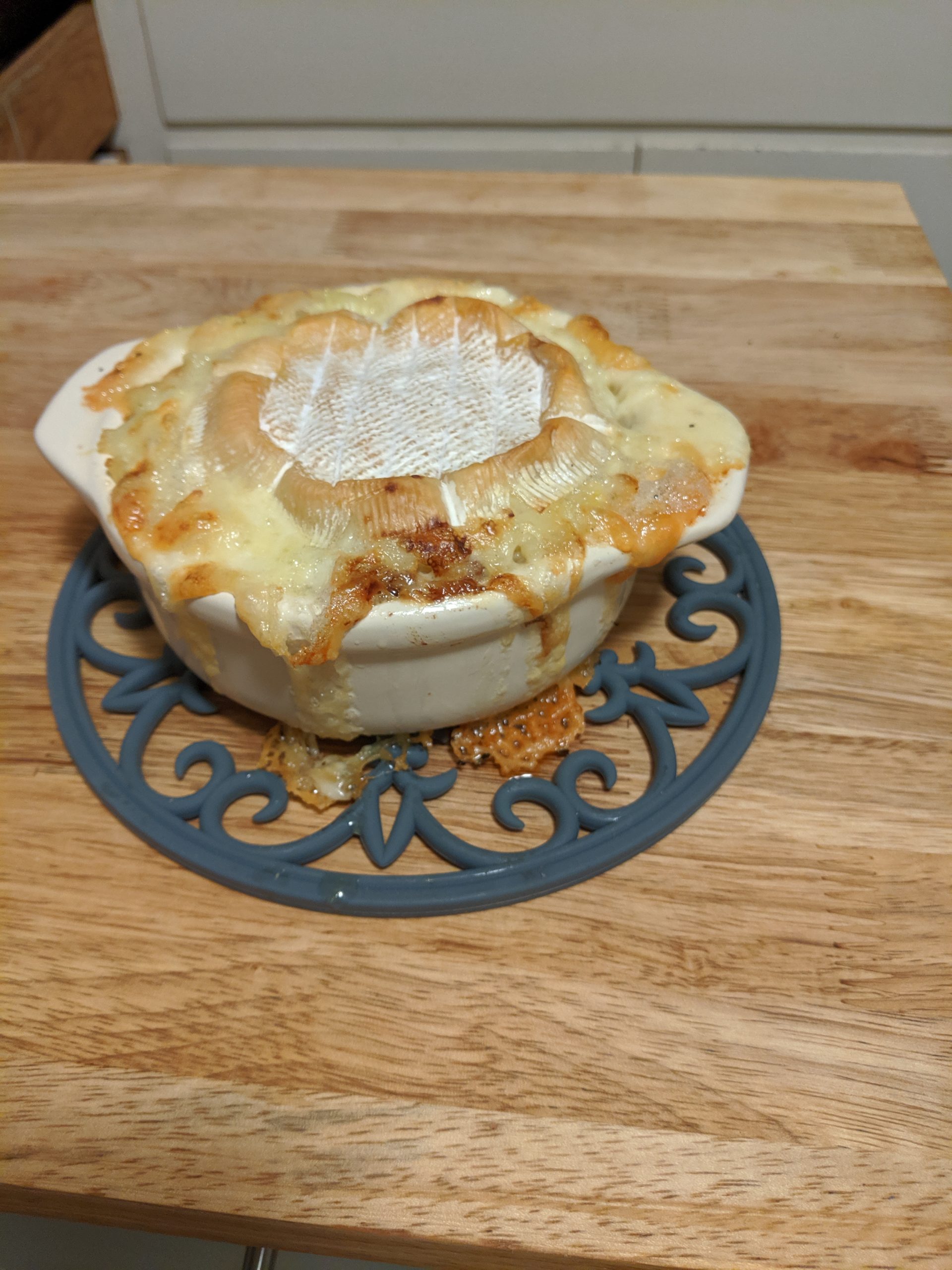
It’s a wee little tartiflette 
My little brie baking dish makes a perfect 2-portion tartiflette 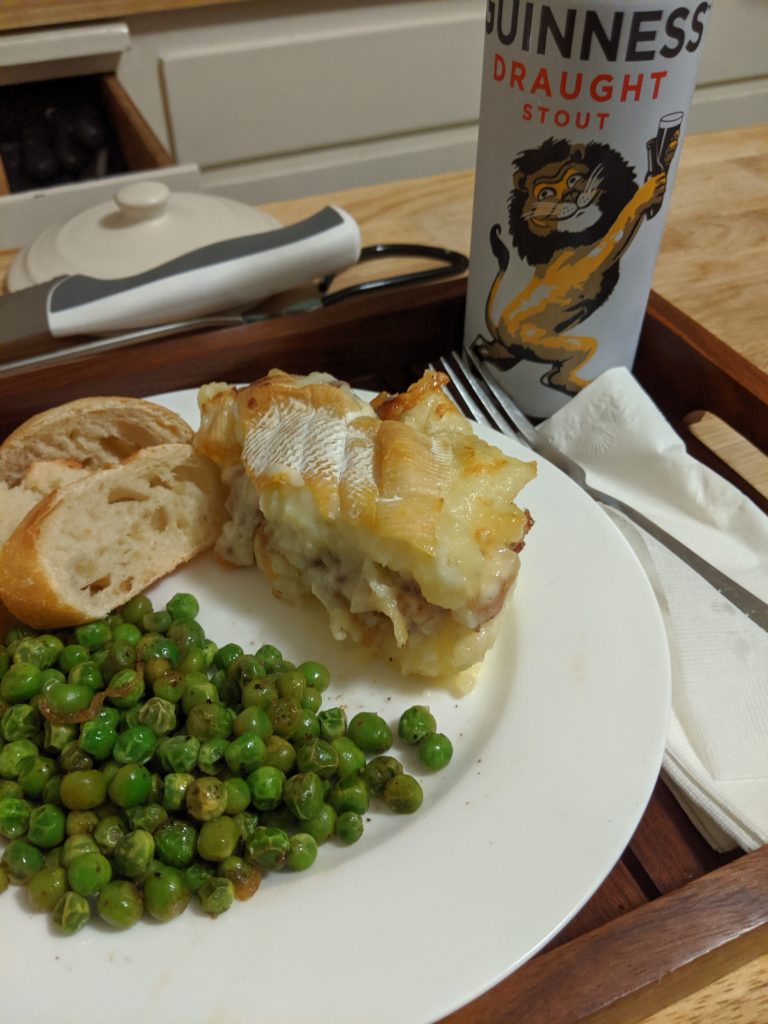
Bubbly gooey cheese!
So what is it?
Tartiflette is a ‘casserole’ in the sense that it is a collection of things mixed together and then baked in a large dish. There’s no cream of mushroom soup or rice, though…. this isn’t a 1970s style casserole. The ingredient list is short: potatoes, onion, bacon, white wine, creme fraiche, and reblochon cheese. In short, it’s layers of potatoes with bacon and onions, topped with a good, smelly cheese, and then baked until a heavenly aroma wafts from the oven and you pull out this dish full of pure comfort. It’s what other comfort foods would eat if they could. There’s nothing surprising or strong, just creamy cheese and salty bacon, and all your cares melt away.
Doing Research
As any dedicated food-lover would do, I tried every version of this dish I could find. Luckily, we were already planning to hit up the Christmas Markets in Europe this year, so I was able to get a lot of research in. We had a tartiflette at the Luxembourg Christmas market. This was one of my favorites. Served straight from a chafing dish, spooned into a heap in the middle of a bowl, this was a perfect cold-weather lunch. I tried it at the Strasbourg, France Christmas market. Here, they prepare “Munsterflette” at most of the booths, where they use Munster cheese instead of reblochon. I think Munster is far too strong and smelly a cheese for this application, though. Along with experimenting, I tried some tartiflette-inspired dishes. One was a tartiflette tarte flambee (say that 3 times fast!). Tarte flambee is an Alsatian style pizza/flatbread with a super thin crispy crust and no tomato sauce. Only cheese and toppings. It’s delicious. But on our visit to Strasbourg, we tried a tarte flambee topped with bacon, potatoes, white wine-onions, and reblochon. This was a wonderful dish, though not nearly as good as a real tartiflette. And finally, we made our way to a fancy French restaurant in Luxembourg called “L’entracte”, and enjoyed a freshly baked tartiflette there. This was wonderful and indulgent and I quite enjoyed it. I think the potatoes, which were cubed rather than sliced, were a bit too firm for my preference, but Joe said he preferred it that way. And with that, I have done my research.

From appearances, it *could* just be cheese… 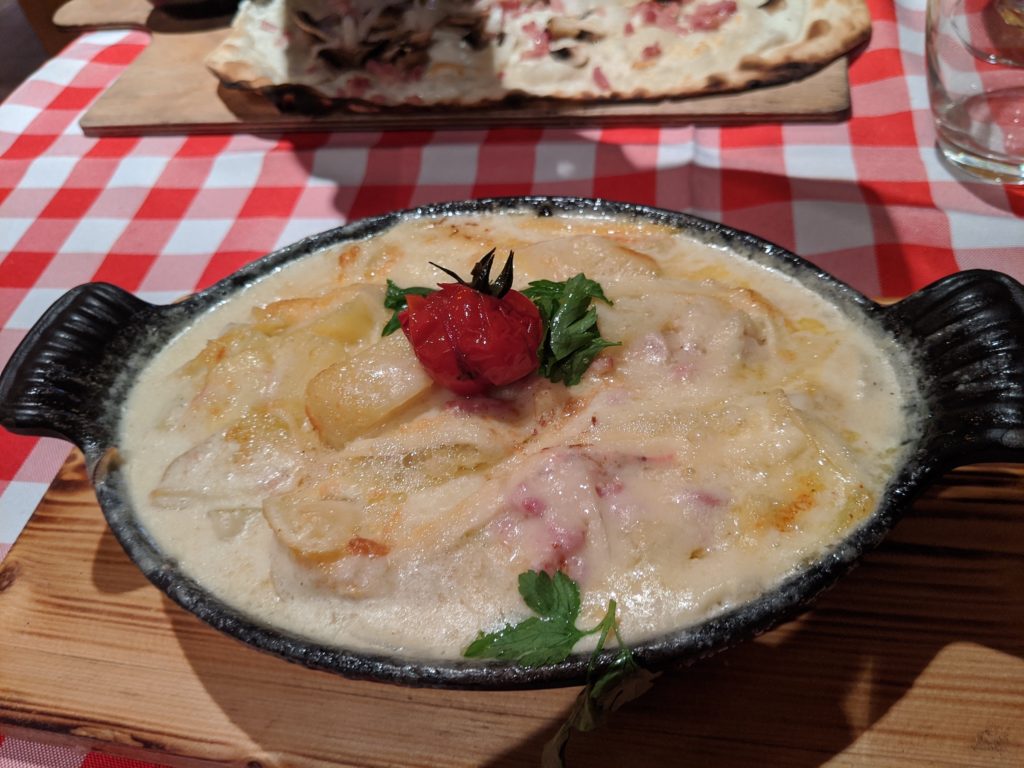
Fancy restaurant-style tartiflette 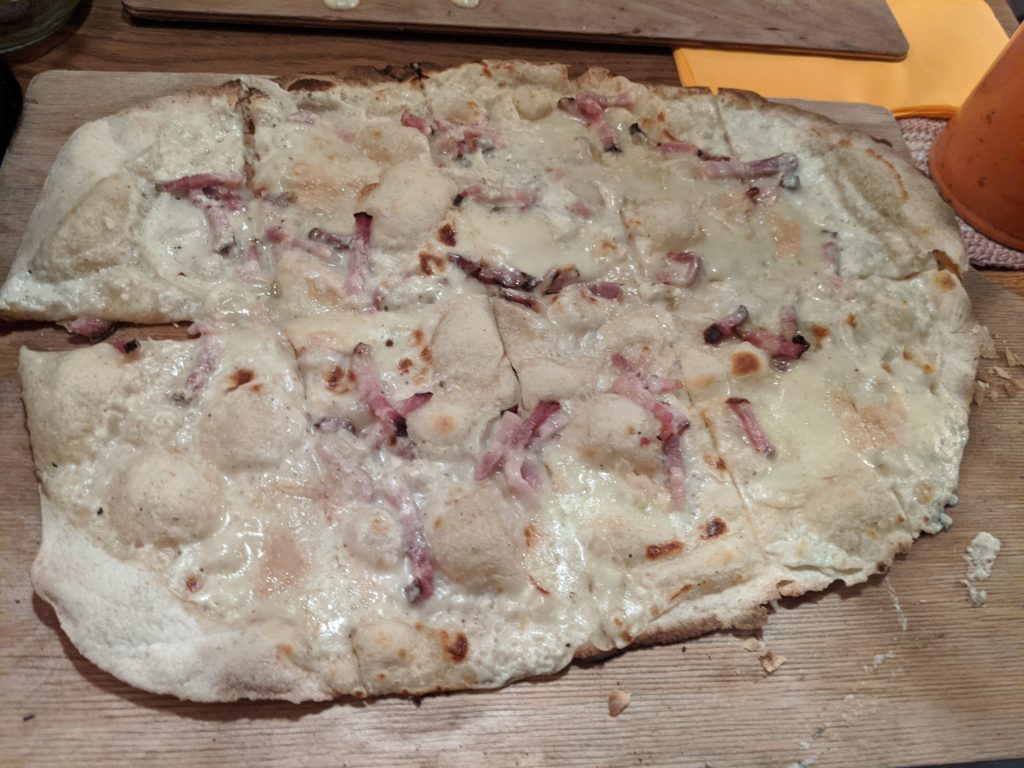
Tartiflette tarte flambee 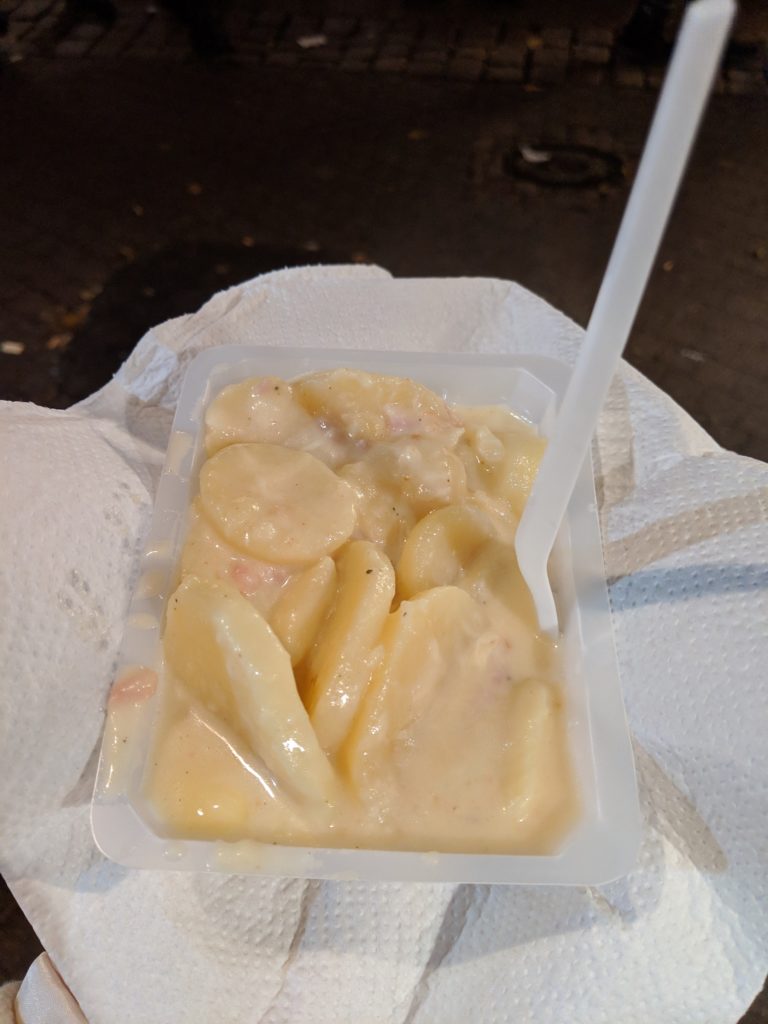
Munsterflette from Strasbourg
Making your own
This isn’t a recipe as much as it’s a technique. You can add more or less of any of the ingredients to your preference and it will still always be delicious. Aside from burning it to a crisp, I will say this is one of the few recipes in the world that is completely fool-proof (though time consuming).
The Ingredients

The ingredients: a short list of indulgent things
The base of this dish is potatoes. Chef John recommends russets, though I have also used yukon golds and didn’t find much of a difference. The potatoes are boiled whole, skin-on, in salted water.

Add potatoes to cold water, then put over heat 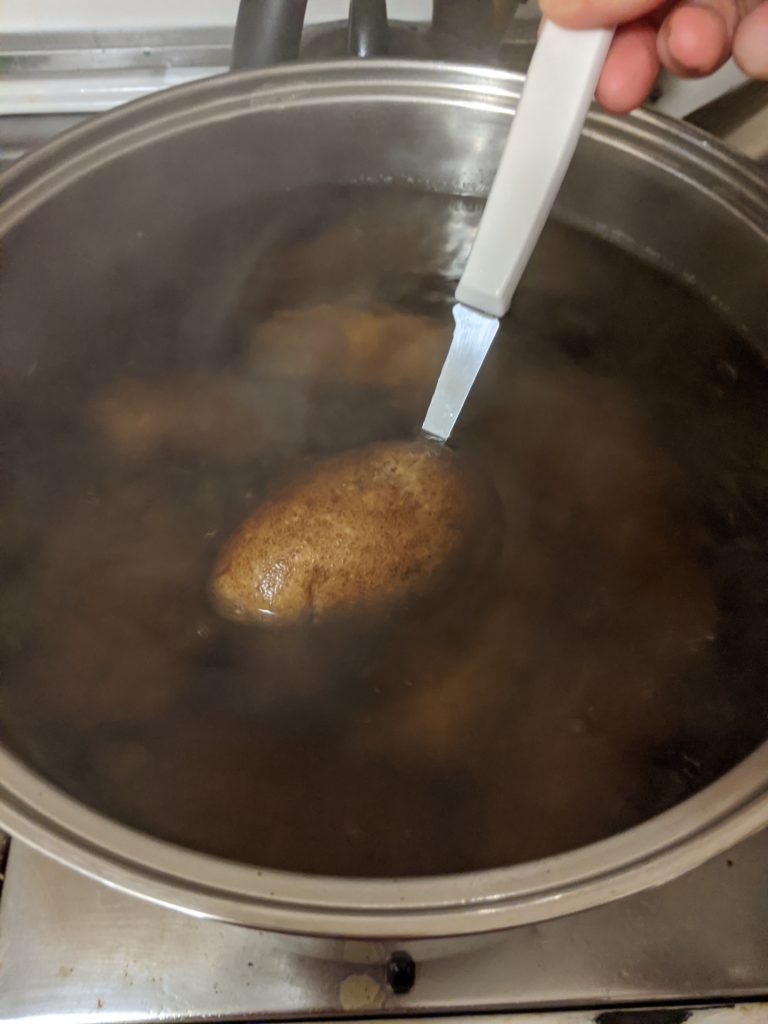
Test the potatoes with a little stabba-stabba. If they don’t swear at you in Russian, they’re ready.
Next, I chop up a half a pound of bacon. I like to use the thick-cut bacon and just make 1/4-1/2-inch wide cuts from the slices. I prefer bacon to be chewy, not crispy, so I always get the thick-cut stuff. I’m sure it would work just as well with crunchy bacon.
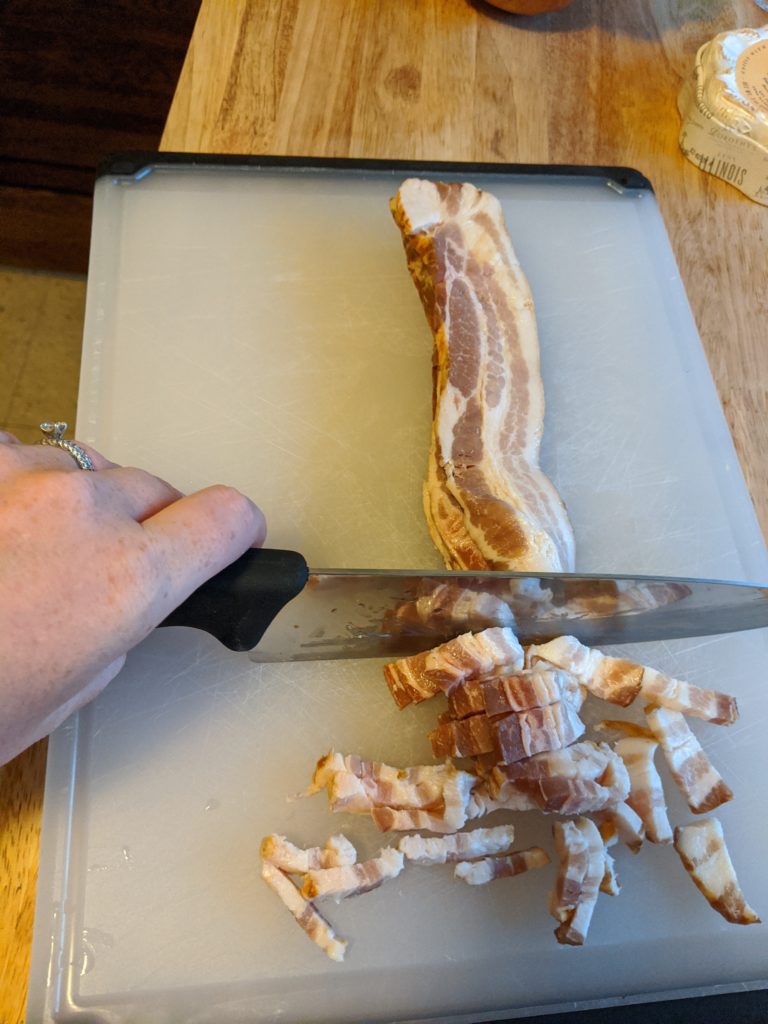
Choppa choppa 
Sautee the bacon 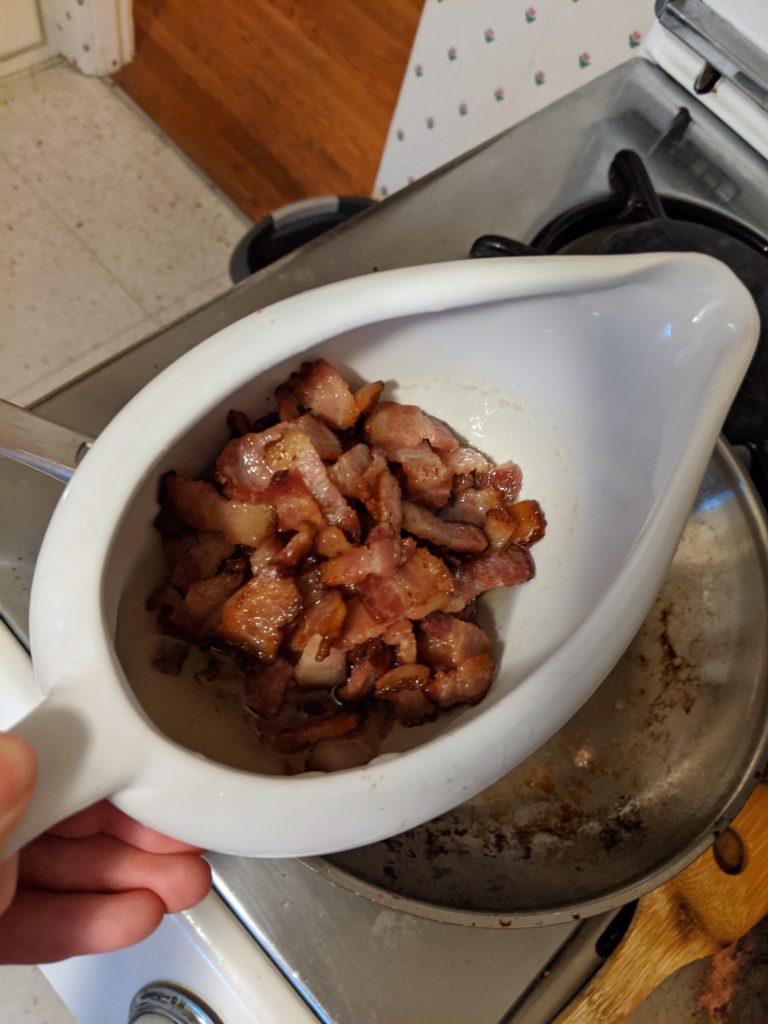
Put bacon in a dish, then pour all of the bacon grease back into the sautee pan
The next ingredient is onion. I go with yellow onions, but once I used a shallot. As long as you get that kind of caramelized onion-y flavor, any kind of onion works.
Eventually, white wine is added to the sautéed onions, so now we have to figure out what kind of white wine to buy. My local Bevmo carries a German riesling from the Mosel river, which is the river that forms the border between Luxembourg and Germany. This is the exact region from which tartiflette was created, so I use this wine. It’s a white wine that isn’t super dry, as I hate chardonnays, but it also isn’t a sweet dessert wine like a moscato either. It’s a very drinkable almost sweet wine. As someone who doesn’t normally drink white wine, I really like this one, and always get 2 bottles so that I have plenty to enjoy while the tartiflette is cooking and then some to drink when it comes out of the oven.
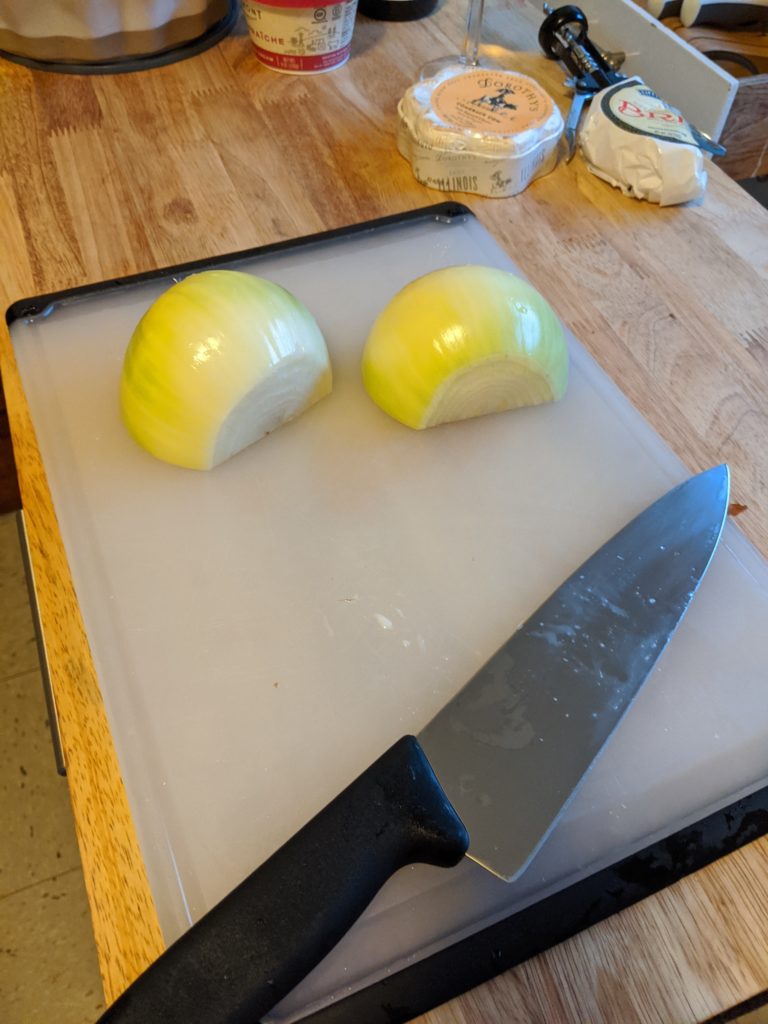
Chop chop master onion 
technically sliced onion 
adding the bacon grease back to the onions 
Some delicious regionally appropriate white wine. 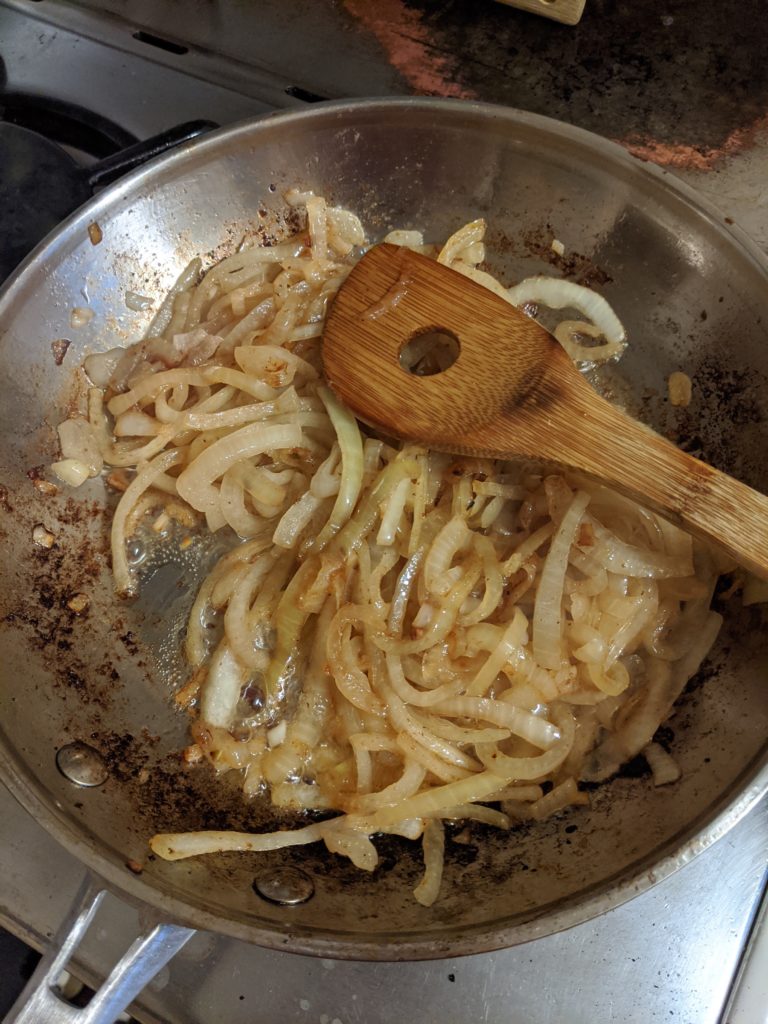
Browning the onions 
Adding white wine 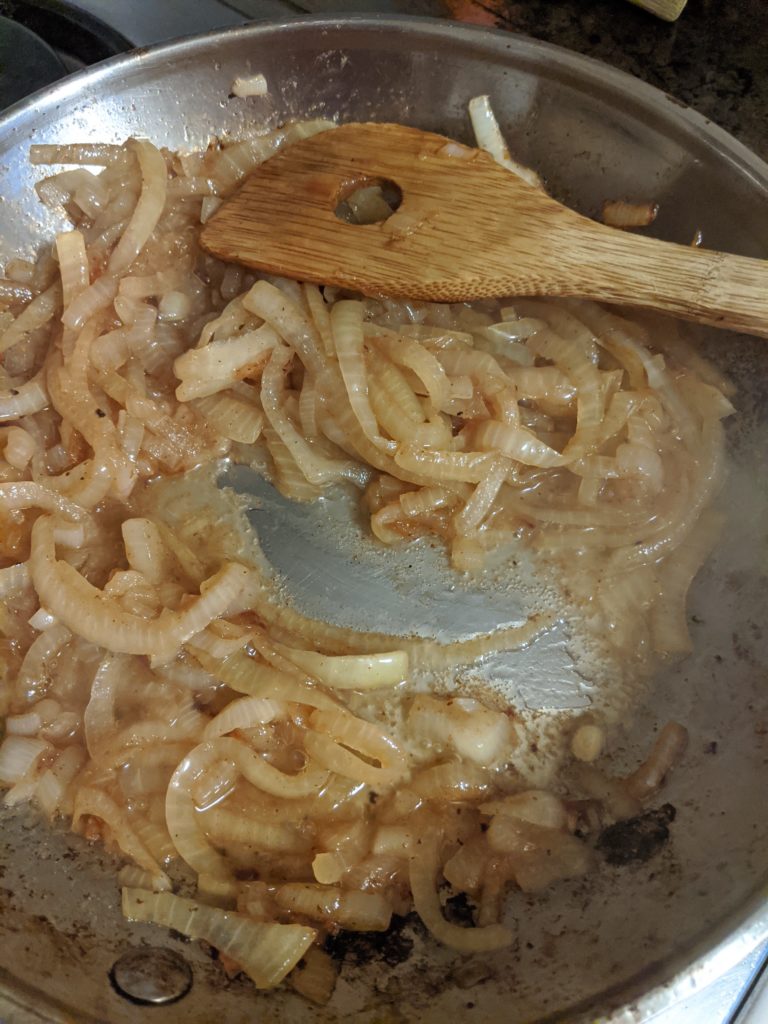
Delicious caramelized white-wine onions
The final ingredient is the dairy products, which consists of reblochon cheese and creme fraiche. Creme fraiche is easy to find in my area, but if you can’t find it, a mild/not super tart Greek yogurt would work just as well, or you can skip it entirely. It’s just there to give the cheese some help in making a smooth, creamy sauce. There’s nothing challenging here until, wait, what’s reblochon?? Yeah…. The one most challenging part of this recipe is ‘Reblochon’ cheese. Reblochon is a French cheese that is a washed rind cheese, so it looks like brie with a white fuzzy outside and a creamy inside. It has a stronger flavor than brie, but isn’t super stinky like some French cheeses. However, true reblochon is made from raw milk and is not aged long enough to be legal to sell in the United States. So…. if you live somewhere where you can’t get real reblochon, what are your options? My favorite option is Dorothy’s Comeback Cow. This cheese, made in Illinois, is available online, and you get free shipping if you buy 3 of them. It smells like hay, a little more aromatic than a normal brie, and I believe it’s the most similar cheese that I’ve found in my experimentation. Though I am happy to have a tartiflette meet-up where everyone brings one made with a different type of cheese and we all try them. Just saying. Other than that, you can go with just plain brie or a mixture of a wheel of brie plus some shredded munster or other slightly stinky cheese that will melt into the brie and give a more reblochon-y flavor.
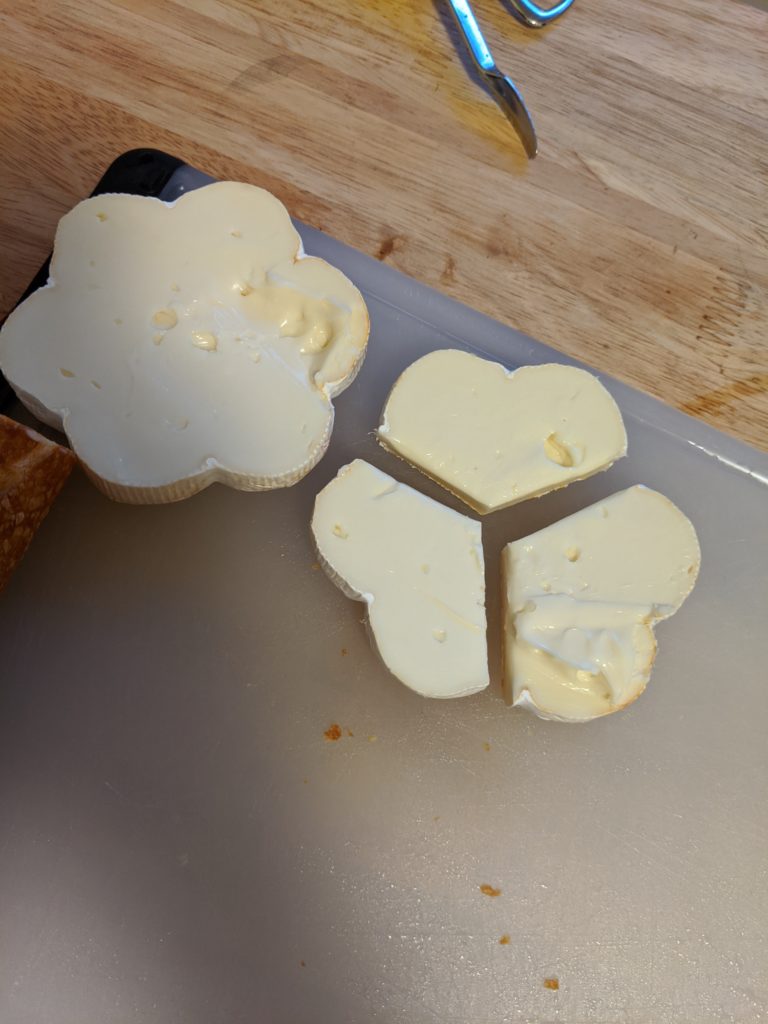
Dorothy’s comeback cow cheese
The process
The process is super simple, but it is time consuming. Each ingredient has to be cooked separately before being combined into a baking dish and cooked together. My record for assembling one of these things is about 2 hours. But, on the plus side, you can assemble it a day or 2 ahead of time and bake it before a big party.
So each of the ingredients has to be cooked first. Boil the potatoes. Sauté the bacon. Remove the bacon to a separate bowl, leaving the fat behind. Sauté the onions in the bacon fat. Add the white wine and reduce the onions in white wine until tender. The cheese wheel should be sliced in half so that you have 2 wheels of cheese with large, exposed surfaces of creamy cheese on one side and the white rind on the other side.

All of the ingredients cooked and ready
Once all of the prep cooking has been done, the assembly begins. Create layers of potatoes, salt/pepper/onion/bacon/creme fraiche, then back to potatoes. Finally, to top off the whole thing, place the cheese wheel face-down on top of the final layer. As it bakes and melts, the cheese will wilt down and become part of the casserole, leaving the decorative rind on top. Don’t overfill the casserole dish, as the cheese needs somewhere to melt. It will run over the sides if the dish is over-full. I like to take a butterknife and poke holes in the casserole top so that the cheese will melt down into them, before baking. Finally, bake this whole concoction for 20-35 minutes.

Layer 1: potatoes 
Sprinkle on half of the bacon 
and half of the onions 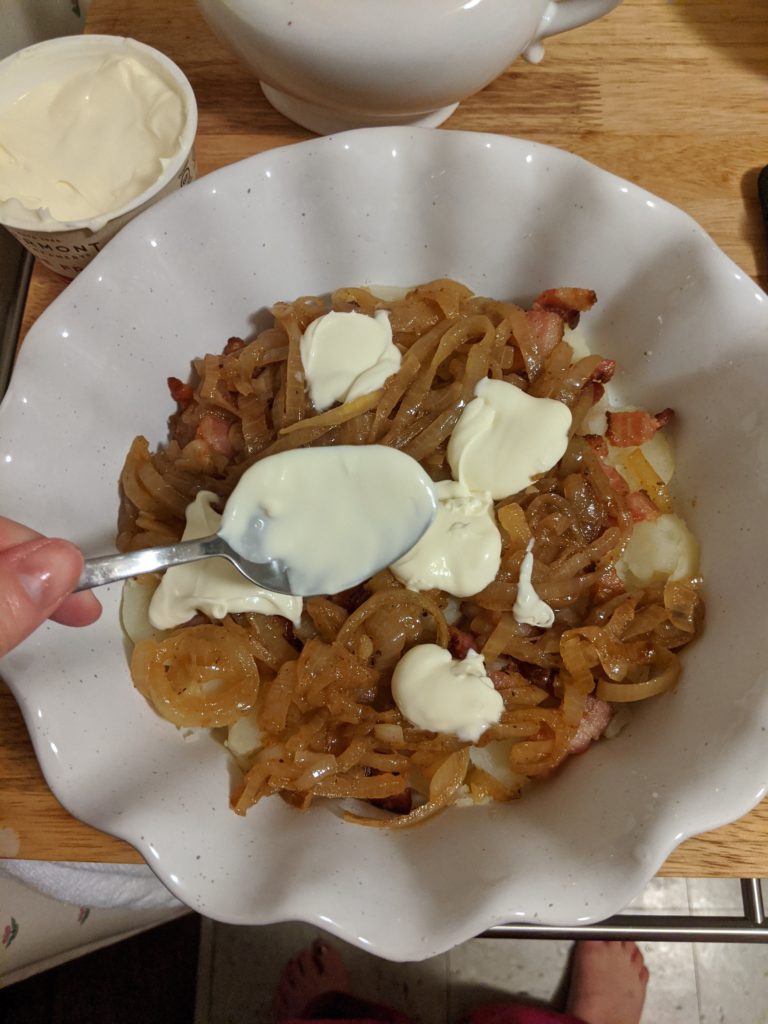
Add half of the creme fraiche 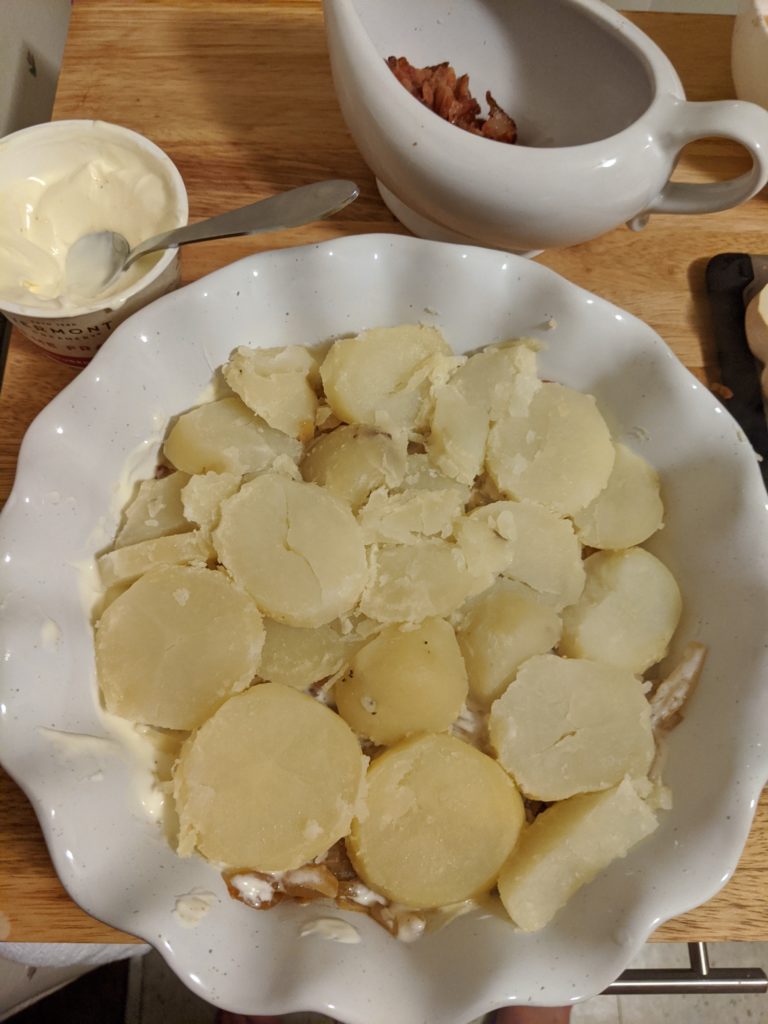
Round 2: more potatoes 
More bacon and onions (more creme fraiche not pictured) 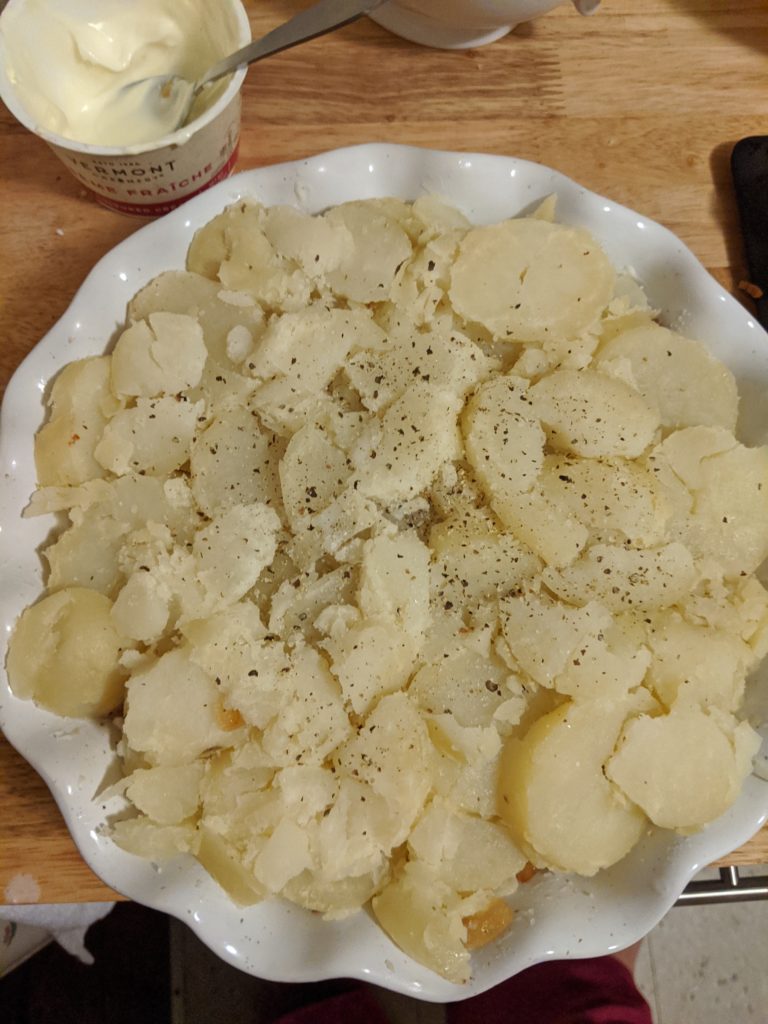
Final layer: add potatoes, the sprinkle with salt and pepper 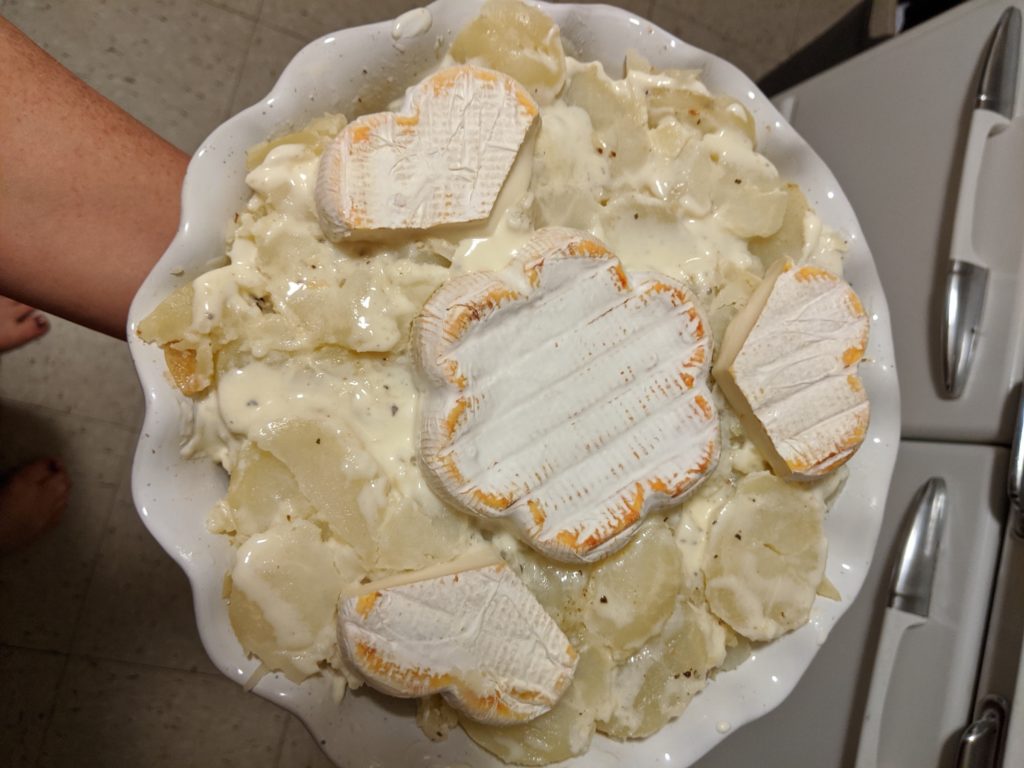
top with cheese, rind side up
Behold your creation. If you went with the Dorothy’s cheese, the presentation is even better, since the cheese wheel is shaped like a flower. This is a heavy dish, and works best as a main dish/entree rather than a potato side dish. Chef John recommends a side salad, but I prefer serving it with green peas and some crusty French bread. I make the peas by tossing them into the bacon/onion pan after I take out the onions, adding a bit of white wine and some salt and pepper, and just cooking them through. They offer a nice pop of sweetness to this salty dish.
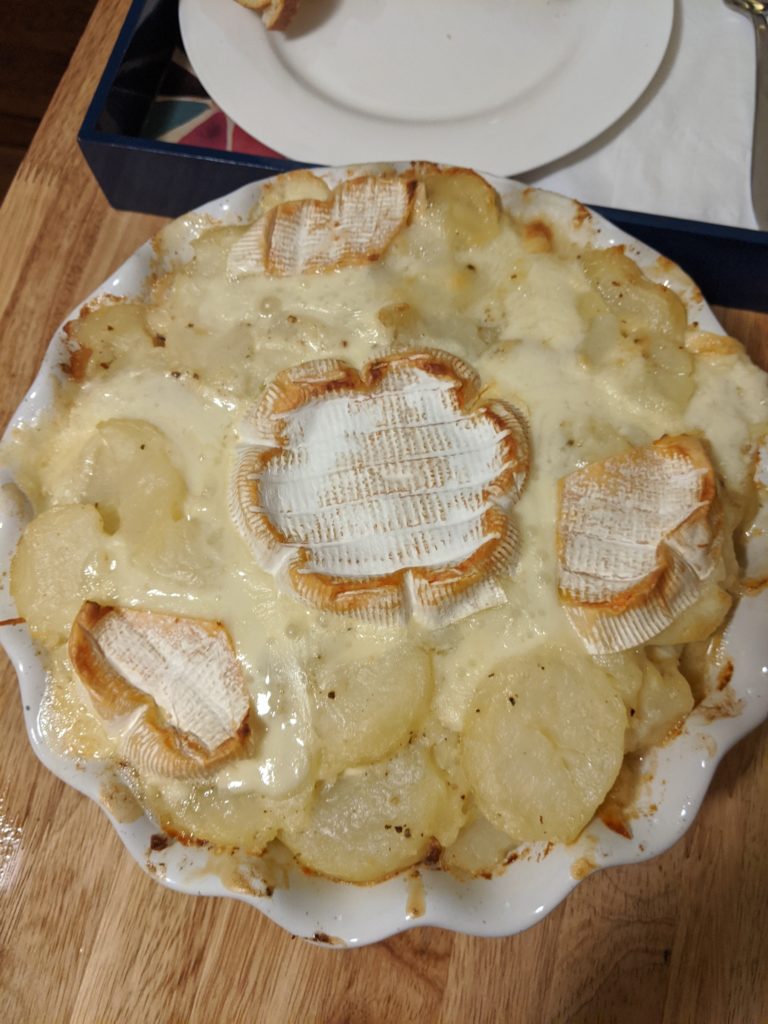
Fresh from the oven 
All those beautiful layers 
Served with green peas and some crusty French bread 
Dog so jealous.
“Recipe”
For those who don’t want to read all of my nonsense and just want the instructions: (or go watch Chef John)
Ingredients
- 3 pounds russet potatoes
- 1/2 pound of bacon, chopped
- 1 onion, sliced in half and then into thin slices
- 1/4 – 1/2 cup white wine
- 8oz creme fraiche
- salt and pepper to taste
Procedure
- Preheat oven to 350F
- Boil potatoes, still in their skin, in well-salted water until cooked through. Knife-test them often, as you don’t want them over-cooked.
- Sauté bacon it in a skillet preferred level of crispness. Once bacon is cooked, remove the bacon but leave behind the bacon fat.
- Sauté onion in the bacon fat until almost soft. Add 1/4-1/2 cup of white wine and simmer until it is mostly evaporated and the onions are cooked through.
- Assemble! Peel the potatoes (under cold water if necessary), and slice them into 1/4-1/2-inch thick slices. Make a layer in the bottom of a casserole or pie dish of potato slices, using about 1/3 of them, and then sprinkle with salt and pepper to taste. Spread half of the bacon, half of the onions, and 1/3 of the creme fraiche over the potatoes. Repeat with another layer of potatoes, salt/pepper, bacon/onions/creme fraiche. Finally, add the last 1/3 of the potatoes, the final 1/3 of the creme fraiche, and some salt and pepper. Cut your wheel of cheese in half, and lay the 2 split wheels creamy-side-down on top of the potatoes.
- Bake for 20-35 minutes at 350ish degrees.
My Favorite sides to go with this dish:

Pound the garlic into a paste 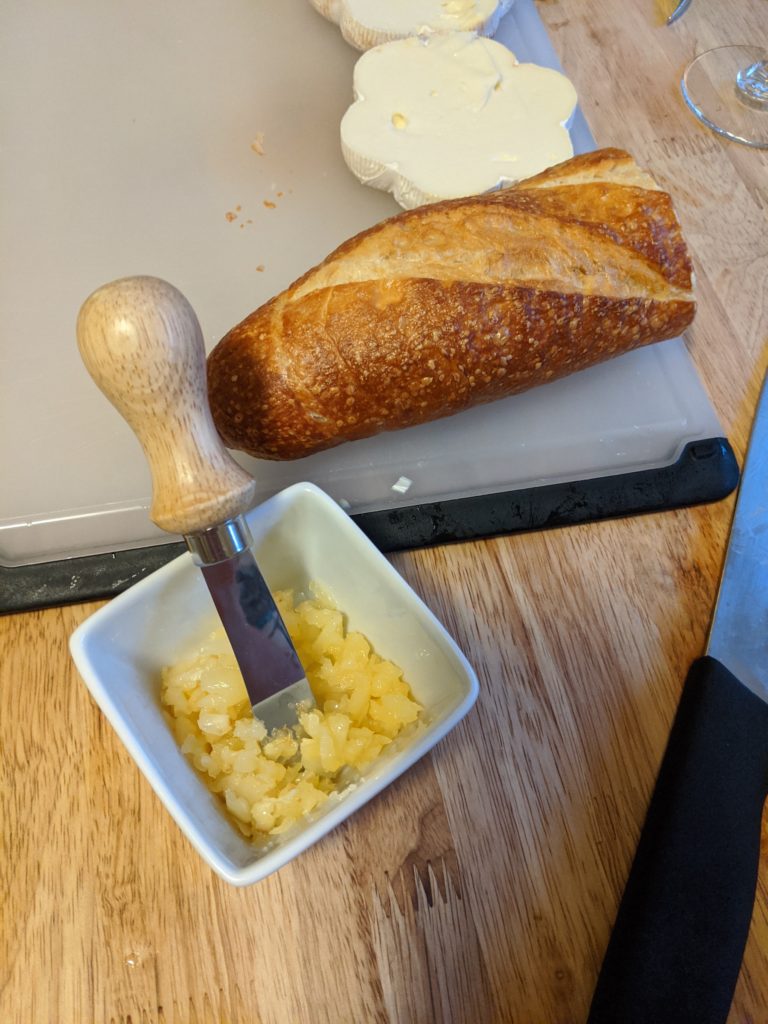
Mix with a bit of olive oil and serve with crusty French bread 
After the onions are removed from the pan, don’t wash it! 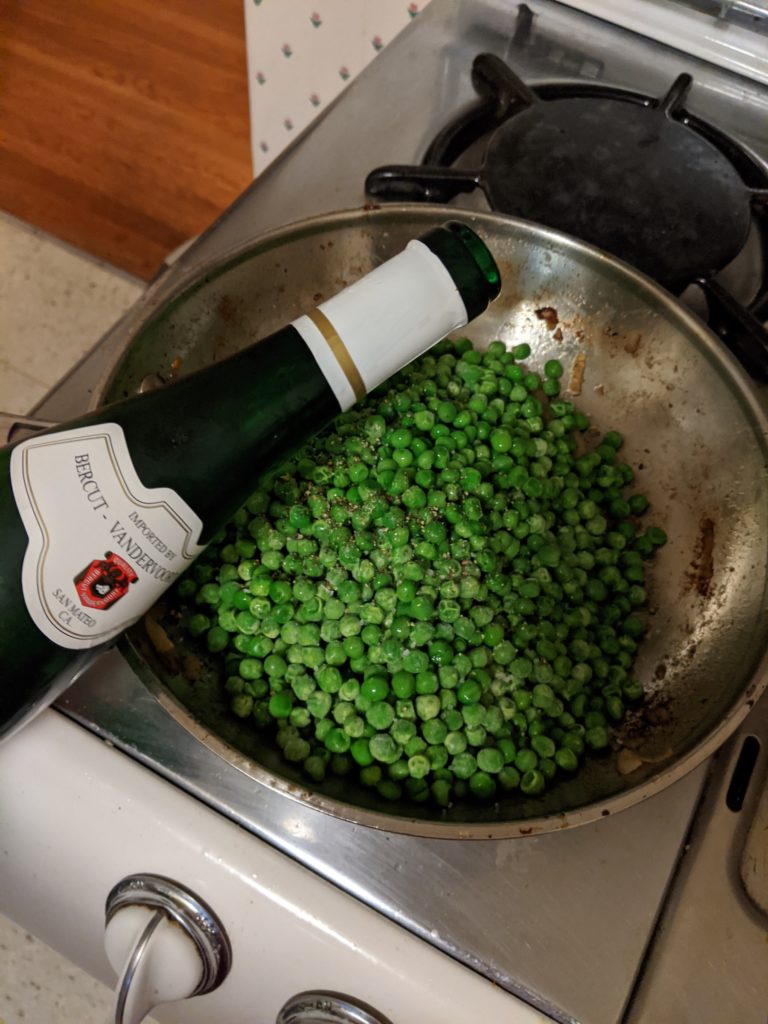
Toss in the green peas, deglaze with some white wine, and add salt and pepper to taste.




